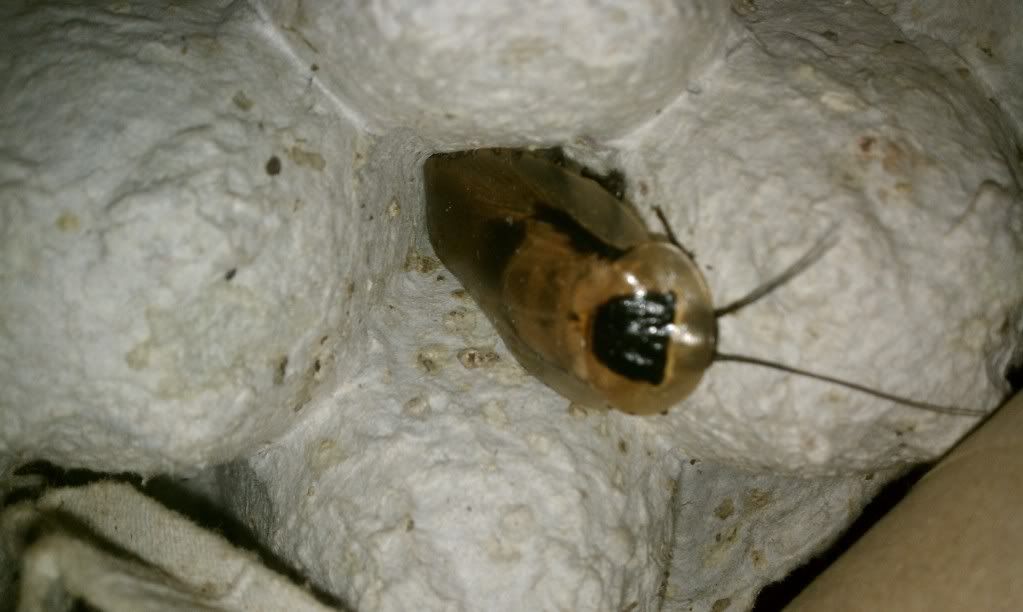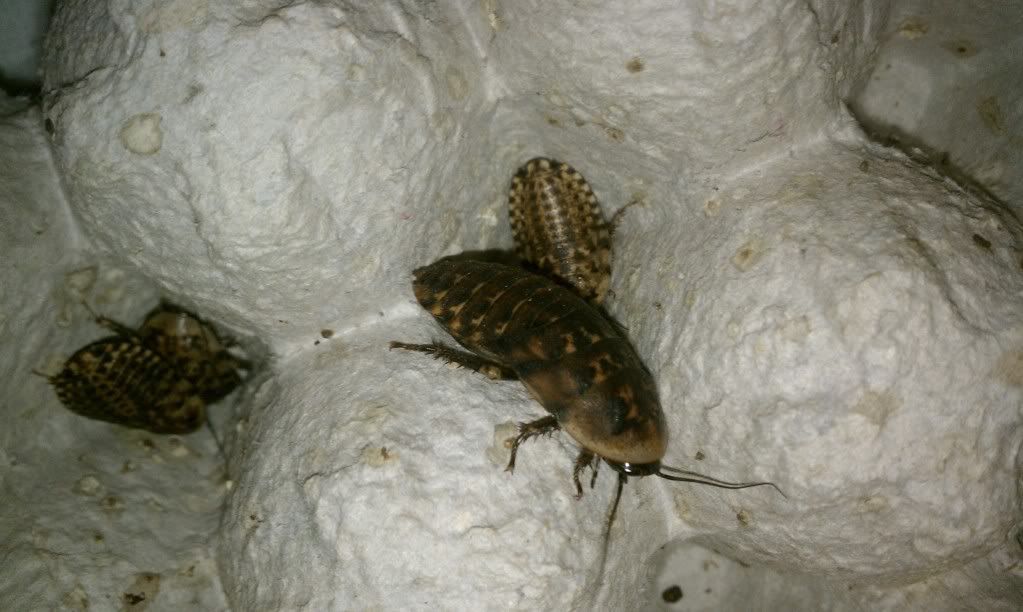Ozymandias
New member
ok so i know alot of people on here recommend and use roaches as a food source. this is my attempt at a general care sheet and to inform people of of other species then B. dubia and B. Lateralis that exist. so far i only have profiles on roaches i have direct experience with, but i will be adding more specie profiles that make good feeders as i get them from a fellow roach hobbyist i know.
also if any one has suggestion on how to improve this care sheet let me know and i will try to update it.
Tropical Roaches are a great alternative the crickets and meal worms. They are more nutritious, easier to keep, easy breed and don’t smell the way crickets do. Because of this I feel they make a superior feeder and the ease of which they can be breed makes them vary affordable. In this we will go through the general care and high light some species that make good feeder roaches.
Housing:
Housing for most roaches is relatively simple, a standard aquarium or other containers works well for all non-climbing species. For climbing species smearing a layer of Vaseline around the top 2-3 inches of the container keeps any from escaping. I find that Sterilite 56qt containers are ideal for larger colonies while the 16qt containers work well for my smaller colonies. For extra surface area for the roaches to climb on use egg flats, it helps if you stand them up vertical so the fras (poop) falls to the ground. I do not use substrate for most my roaches; I find it’s easier to maintain them without it, but there are a few that do benefit from the use of substrate.
Food & water:
Water crystals are the best options for watering many species of roaches. For those who don’t know water crystals are a synthetic material that absorbs water so that it looks like a crystal but feels like a gel substance. Because of these properties roaches can’t drown in it in it, I have even found baby dubia nymphs hiding it in at times. For actual water container you can use a deli cup with slits cut in the sides or use a low bowl so roaches can reach the crystals.
Food is also pretty simple and there are a lot of options open on what to feed, but because these are feeder roaches and thus going to eaten by your animals the main diet should be a good quality gutload. It is also important to give these guys fresh fruit and vegetables. I tend to use a lot of bananas, apples, oranges and carrots but you can use others. For food bowls you can be anything just make sure that the roaches can get in and out of it.
Another option for gutload is to separate the nymphs or full grow adults you are planning to use in a given week in to a separate container and gutload them there.
Warning: do not feed dog food to your roaches as this can lead to serious health problems.
Heat & Humidity:
Because these species come from warmer climates temperature and humidity is very important. The optimal temperature range for most of these roaches is from 80-95 degrees with humidity usually above 50%, High temps = more breeding. They will stop breeding though below 78 degrees and will start dieing off below 60 degrees, so heat is very important.
Non-climbing or flying species:
Blatta Lateralis:
Common names are Turkish roach or rusty red roach. These guys are smaller than dubia and discoid, adults are the size of a large crickets and nymphs can be as small as 1/8 of an inch. These guys are faster than dubia roaches but nowhere near as fast as some people make them out to be. Also unlike dubia they are egg layers and will scatter eggs everywhere. Just leave them alone and eventually they will hatch after a month or so.
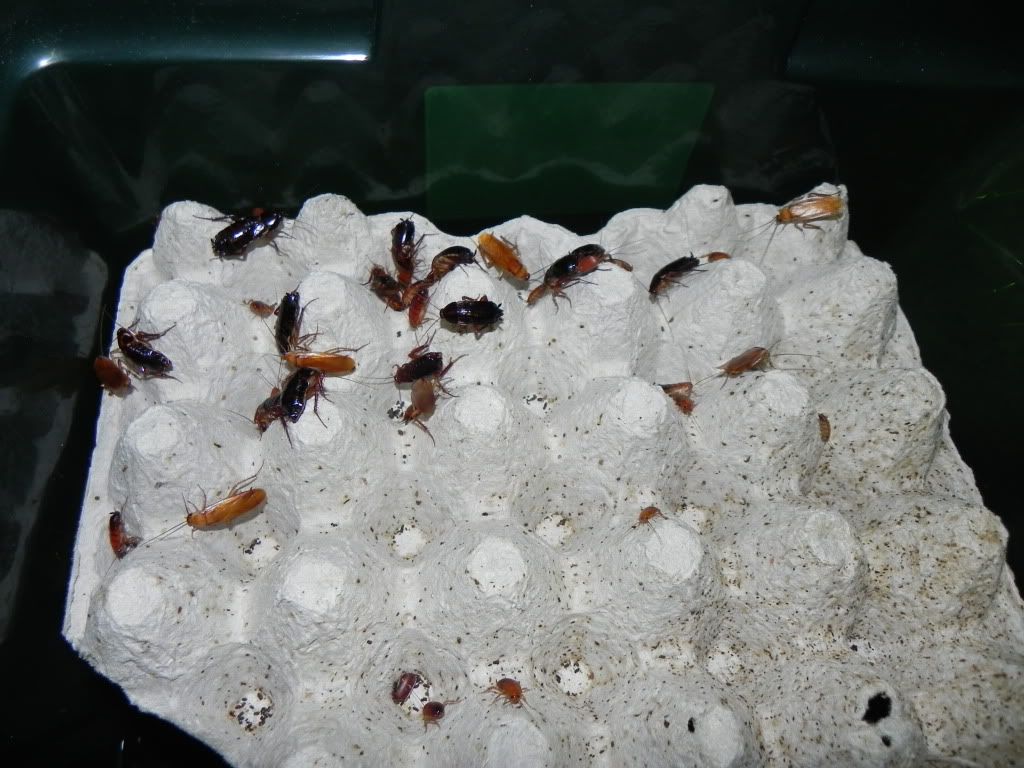
Blaptica dubia:
Another name for these guys is Guyana spotted roach they are one of the more popular species of feeder roaches. Adult are 1 ½ to 2 inches while baby are around ¼ of an inch when born. These are also one of the easier species to sex with males having wings and females no having wings. These guys are livebearers so no need to worry about egg sacks (ooths), and each female will have around 20-30 young every month or so.
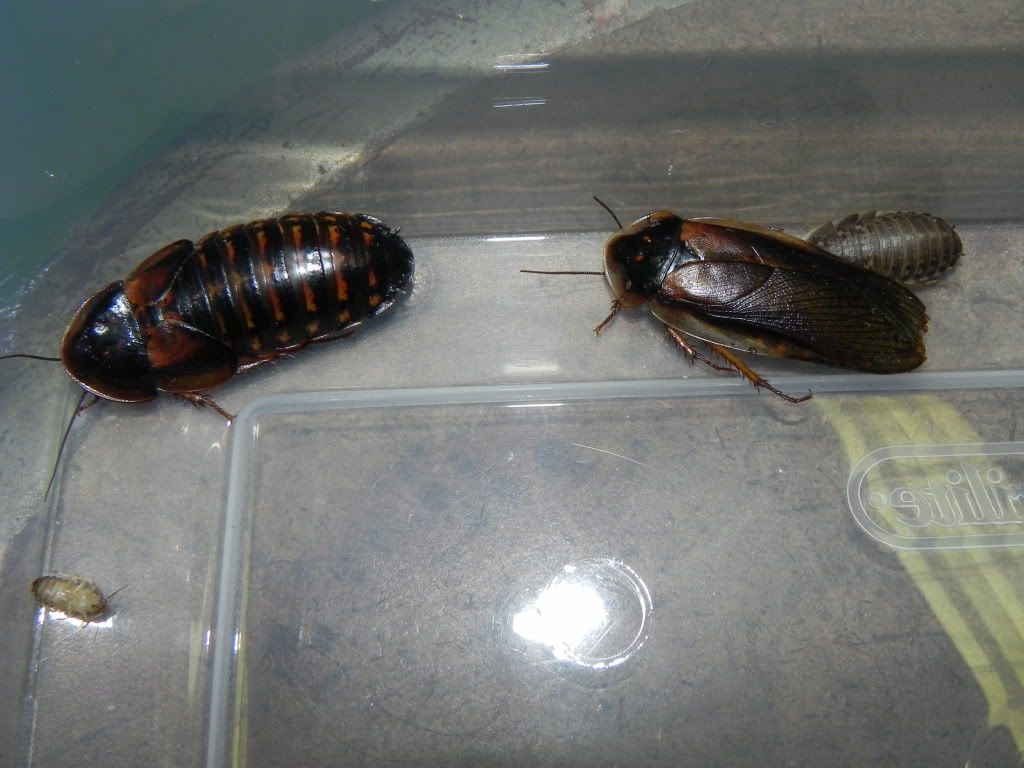
Top: Female on left Male on right
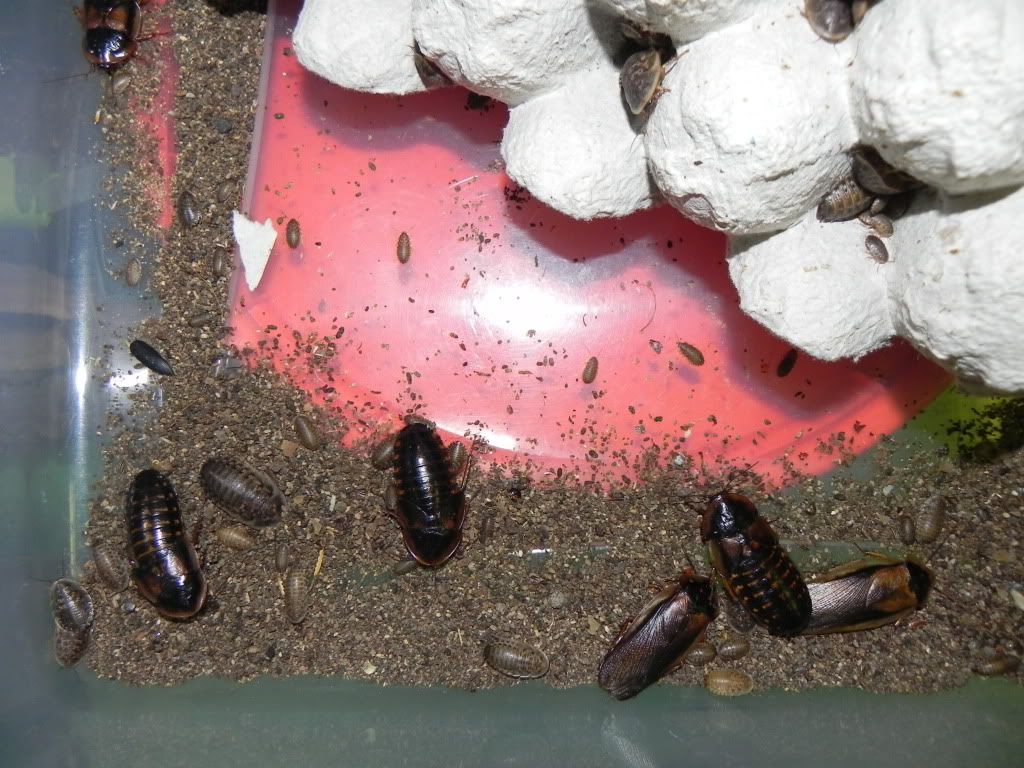
Warning: b. dubia are illegal in Florida but because discoid roaches are native to Florida and are legal there thay make a good alternative for Florida residence.
Byrsotria sp. "Cuba" (Brown Burrowing Roach)
this roach is extremely similar to B. dubia in both appearance and care. the main difference is that males are shorter but fatter and females are in general bigger.
Male:
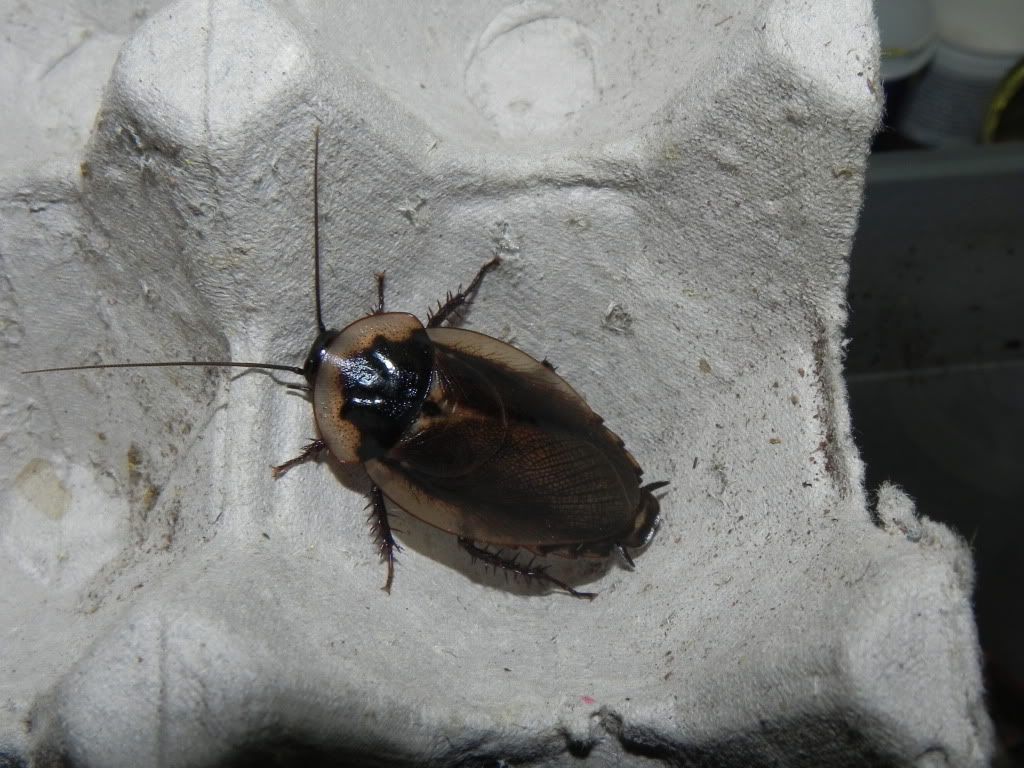
Female:
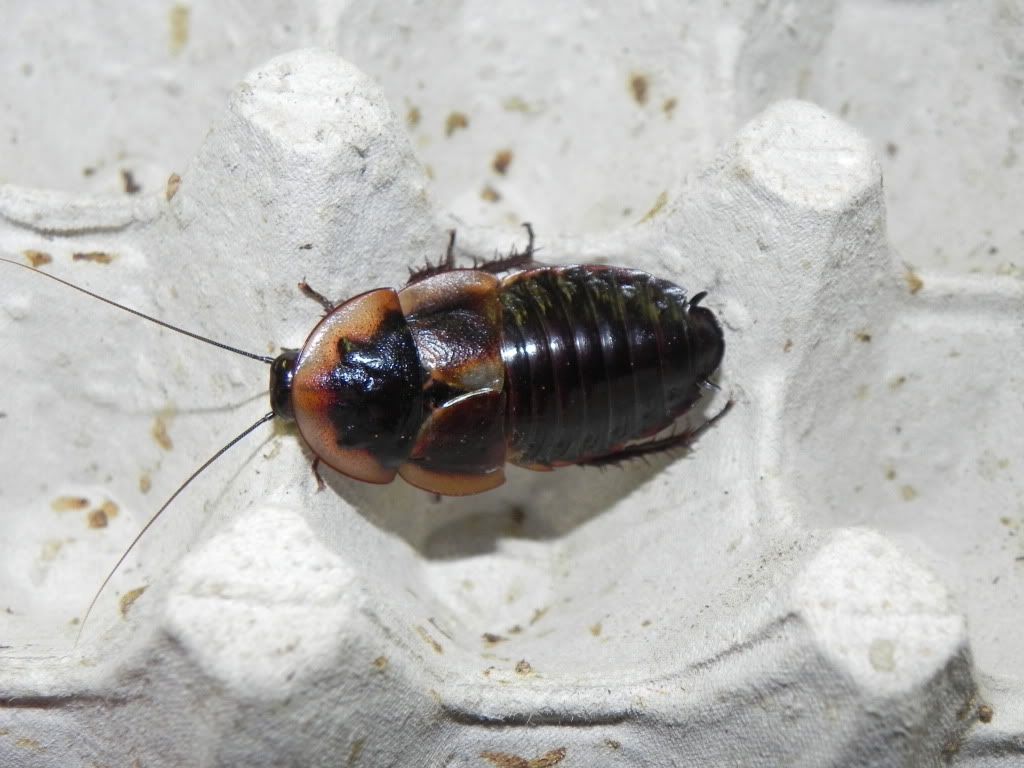
Blaberus discoidalis:
Discoid roach and false death head are two common names for these guys. These are similar to B. dubia with one major difference; both males and females have full wings. An easy way to sex these guys is by looking at their underbelly, males have light and dark striping while females are almost entirely dark. Also like b. dubia these guys are livebearers and give birth to 20-30 roaches.
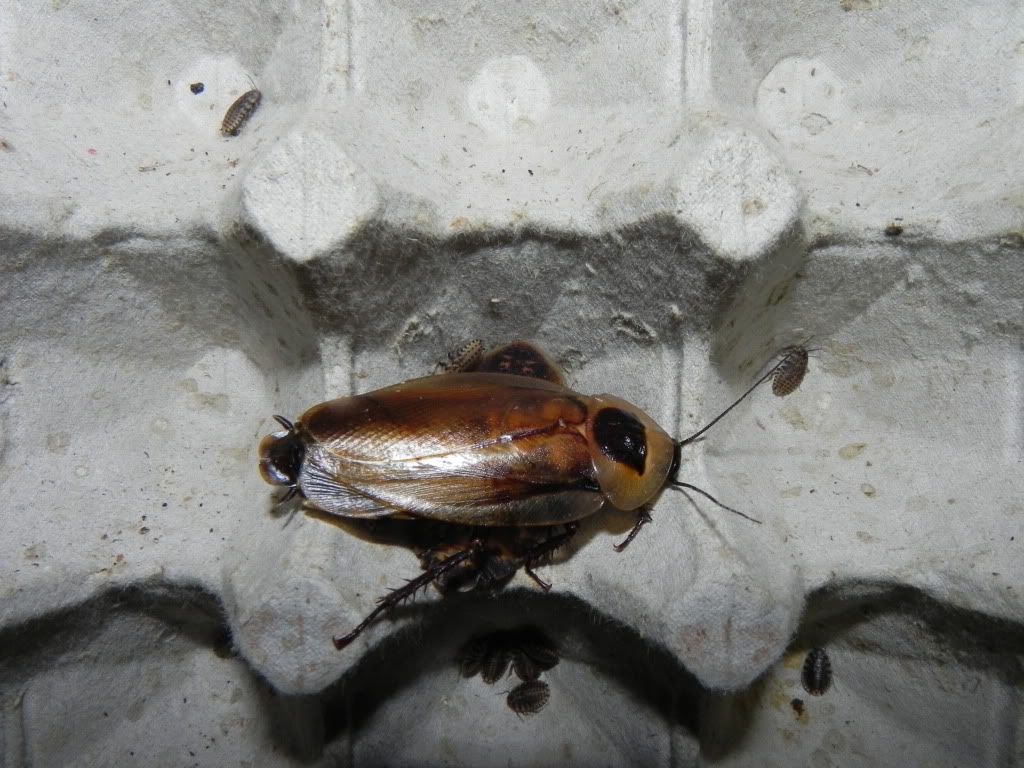
Eublaberus prosticus:
Otherwise known as the Orange Head, this is a new species for me to star rising but quite happy with them so far. Both male and female have wings and are a nice rusty orange brown color and nymphs are deep orange red. Size wise adults are usually around 2” wile nymphs usually start out with 1/4'”. With these guys, heat is important and should be keep in the 90’s to get optimal breeding and humidity should be kept relatively high. Also Orange Heads are notorious wing bitter so a source of protein should be available at all times. If these requirements are met they are one of the faster breeding species of the larger bodied roaches.
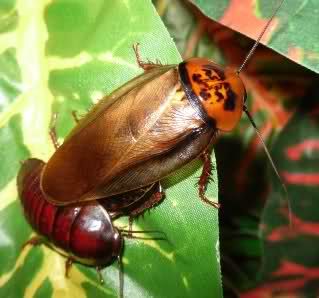
Photo by Zephyr (Kyle) from All Pet Roaches Forum
Climbing and flying species:
Naupheta cinerea:
Lobster roaches are one of the more popular climbing species out there. They are relatively small species reaching around 1½" as adults and around 3/16” when born. These guys are glass climbers but not all that great at it so a 3-2 inch of barrier of Vaseline around the top of the enclosure should keep them in. also they seem to be a bit more cold tolerant than others but breed vary regularly, probably one of the easier roach to breed which makes them a good feeder.
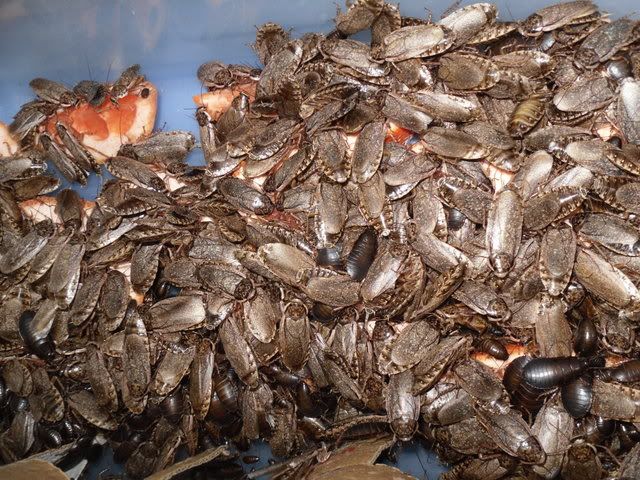
Photo by Zephyr (Kyle) from All Pet Roaches Forum
Phoetalia pallida + Oxyhaloa duesta (Pallid and Red Head Roach)
Housing: Small container (compared to colony size) with lots of egg crates; coconut fiber for substrate is recommended to keep humidity levels buffered. A barrier must be applied since both species climb.
Size: P. pallida are usually .7" to 1"while O. duesta tend to be 0.5"to 0.9" P. pallida grows larger and has smaller newborn nymphs, while O. duesta grows smaller but has larger newborns.
Temperature: Optimal reproduction will occur from 78-85 degrees Fahrenheit.
Humidity: Fairly high; both species dry out quickly. Ventilation is necessary, though.
Other notes: Very easy to culture. For larger cultures, I recommend introducing a colony of Alphitobius diaperinus which will eat dead roaches and scraps.
Reproduction: O. duesta; Females will give live birth to babies every 3 weeks or so. This species has a "reproductive trend" where a lot of babies pop up at once but for a bit after only a few will. P. pallida; Females will give birth every 3 weeks to a month. This species reproduces steadily.
Oxyhaloa duasta “Red Head Roach”
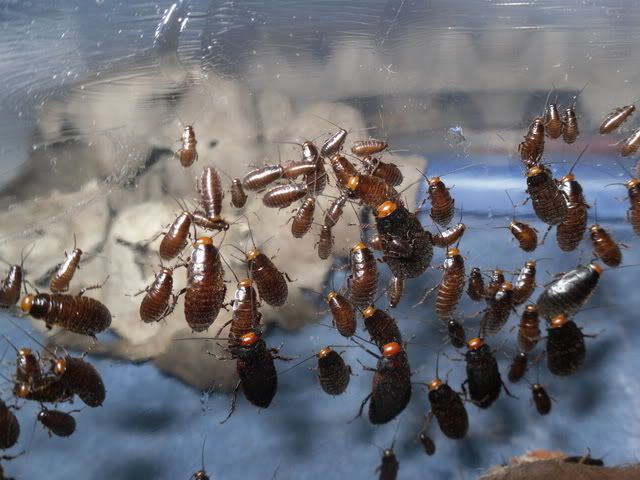
Phoetallia pallada “Pallid Roach”
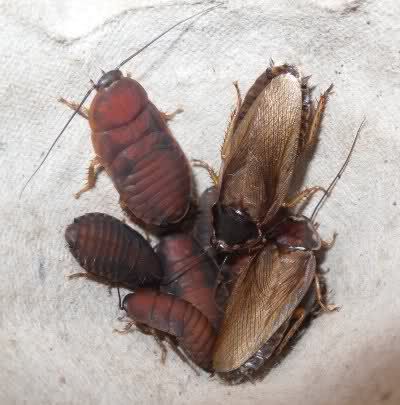
Photo and info on P. pallada and O. duasta by Zephyr (Kyle) from All Pet Roaches Forum
Panchlora nivea (Green Banana Roach)
Housing: Small container (compared to colony size) with a good 2"-3" of substrate. Coconut fiber with sphagnum moss for aeration is ideal. Egg crates or bark can be used on top of this. A barrier must be used since the adults can climb and fly. The nymphs cannot.
Size: .5"-.9" The newborns are incredibly tiny; Roughly 1/2 a millimeter.
Temperature: 78-88 degrees Fahrenheit.
Humidity: HIGH. This species will die very quickly if it dries out. One side of the container (at least!) should be soaking wet. A small ventilation hole is necessary, though.
Other notes: Fairly easy to culture. For larger cultures, I recommend introducing a colony of Alphitobius diaperinus which will eat dead roaches and scraps. A tight fitting lid is vital for preventing escapes.
Reproduction: The females will give birth every 2 week-1 month depending on temperature. This species is live-bearing.
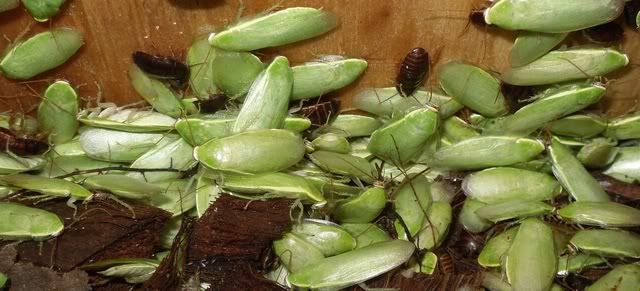
Photo and info on P. nivea by Zephyr (Kyle) from All Pet Roaches Forum
Pycnoscelus femapterus & Pycnoscelus surinamensis & Pycnoscelus nigra
These are three very interesting roaches they are both fairly small roach about an inch in length. Surinamensis & Nigra are Parthagenic meaning the entire populations is made up females. Femapterus on the other hand have both males and females, only the males have wings and are quite a bit smaller. Fair warning nymphs are small really small. Also larger surinamensis nymphs can climb smooth surfaces and adult Male femapterus can flutter and climb, but both species spend more of their time buried. Thay like to burrow so proved them a good 2 inches of dry substrate I use a mix of leaf litter, cocofiber, sand and coconut chunk. Other than that these guys are easy to breed and keep and should make a good feeder
Pycnoscelus surinamensis
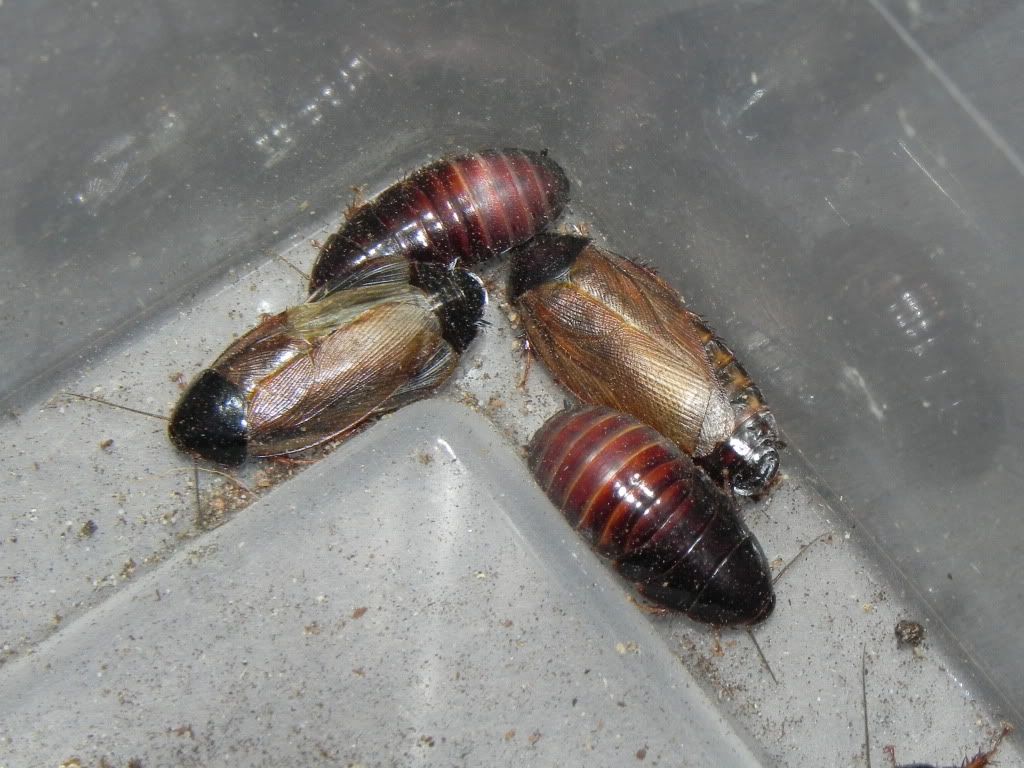
Pycnoscelus nigra
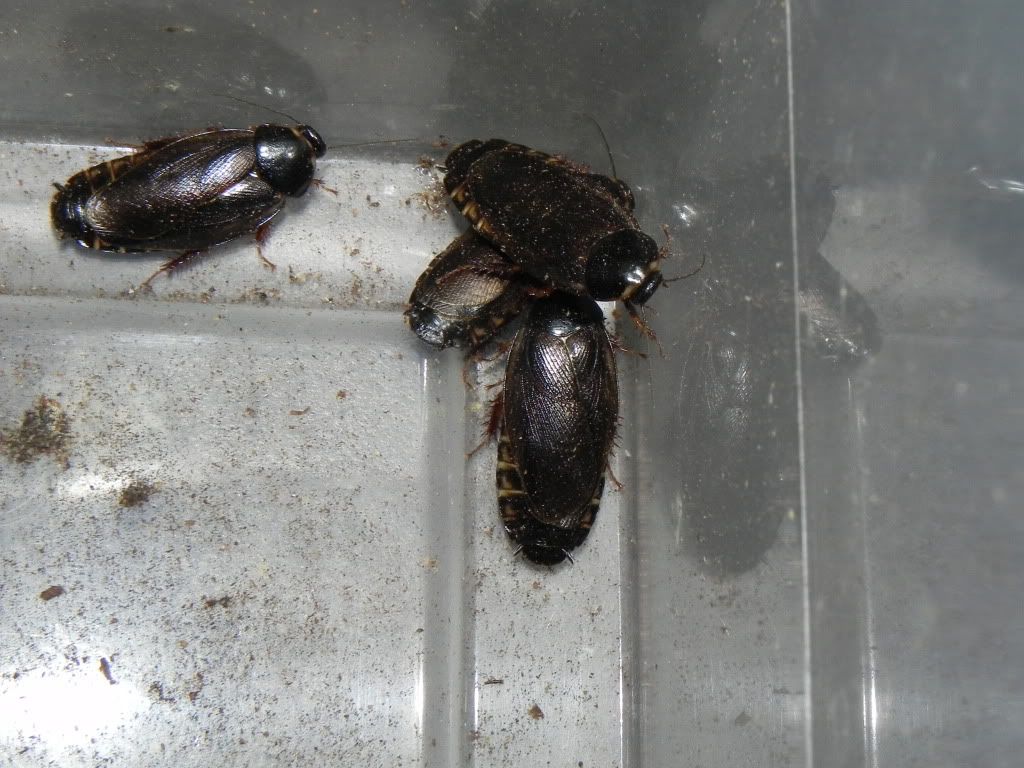
Pycnoscelus femapterus
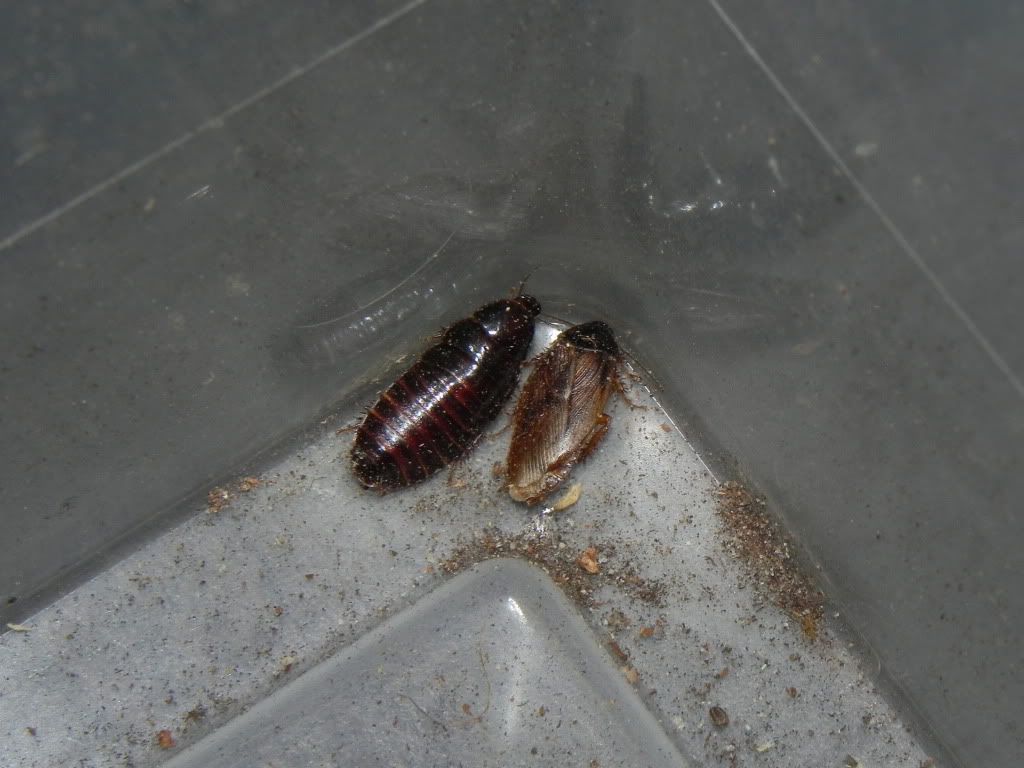
also if any one has suggestion on how to improve this care sheet let me know and i will try to update it.
Feeder Roach care and breeding:
Tropical Roaches are a great alternative the crickets and meal worms. They are more nutritious, easier to keep, easy breed and don’t smell the way crickets do. Because of this I feel they make a superior feeder and the ease of which they can be breed makes them vary affordable. In this we will go through the general care and high light some species that make good feeder roaches.
Housing:
Housing for most roaches is relatively simple, a standard aquarium or other containers works well for all non-climbing species. For climbing species smearing a layer of Vaseline around the top 2-3 inches of the container keeps any from escaping. I find that Sterilite 56qt containers are ideal for larger colonies while the 16qt containers work well for my smaller colonies. For extra surface area for the roaches to climb on use egg flats, it helps if you stand them up vertical so the fras (poop) falls to the ground. I do not use substrate for most my roaches; I find it’s easier to maintain them without it, but there are a few that do benefit from the use of substrate.
Food & water:
Water crystals are the best options for watering many species of roaches. For those who don’t know water crystals are a synthetic material that absorbs water so that it looks like a crystal but feels like a gel substance. Because of these properties roaches can’t drown in it in it, I have even found baby dubia nymphs hiding it in at times. For actual water container you can use a deli cup with slits cut in the sides or use a low bowl so roaches can reach the crystals.
Food is also pretty simple and there are a lot of options open on what to feed, but because these are feeder roaches and thus going to eaten by your animals the main diet should be a good quality gutload. It is also important to give these guys fresh fruit and vegetables. I tend to use a lot of bananas, apples, oranges and carrots but you can use others. For food bowls you can be anything just make sure that the roaches can get in and out of it.
Another option for gutload is to separate the nymphs or full grow adults you are planning to use in a given week in to a separate container and gutload them there.
Warning: do not feed dog food to your roaches as this can lead to serious health problems.
Heat & Humidity:
Because these species come from warmer climates temperature and humidity is very important. The optimal temperature range for most of these roaches is from 80-95 degrees with humidity usually above 50%, High temps = more breeding. They will stop breeding though below 78 degrees and will start dieing off below 60 degrees, so heat is very important.
Non-climbing or flying species:
Blatta Lateralis:
Common names are Turkish roach or rusty red roach. These guys are smaller than dubia and discoid, adults are the size of a large crickets and nymphs can be as small as 1/8 of an inch. These guys are faster than dubia roaches but nowhere near as fast as some people make them out to be. Also unlike dubia they are egg layers and will scatter eggs everywhere. Just leave them alone and eventually they will hatch after a month or so.

Blaptica dubia:
Another name for these guys is Guyana spotted roach they are one of the more popular species of feeder roaches. Adult are 1 ½ to 2 inches while baby are around ¼ of an inch when born. These are also one of the easier species to sex with males having wings and females no having wings. These guys are livebearers so no need to worry about egg sacks (ooths), and each female will have around 20-30 young every month or so.

Top: Female on left Male on right

Warning: b. dubia are illegal in Florida but because discoid roaches are native to Florida and are legal there thay make a good alternative for Florida residence.
Byrsotria sp. "Cuba" (Brown Burrowing Roach)
this roach is extremely similar to B. dubia in both appearance and care. the main difference is that males are shorter but fatter and females are in general bigger.
Male:

Female:

Blaberus discoidalis:
Discoid roach and false death head are two common names for these guys. These are similar to B. dubia with one major difference; both males and females have full wings. An easy way to sex these guys is by looking at their underbelly, males have light and dark striping while females are almost entirely dark. Also like b. dubia these guys are livebearers and give birth to 20-30 roaches.

Eublaberus prosticus:
Otherwise known as the Orange Head, this is a new species for me to star rising but quite happy with them so far. Both male and female have wings and are a nice rusty orange brown color and nymphs are deep orange red. Size wise adults are usually around 2” wile nymphs usually start out with 1/4'”. With these guys, heat is important and should be keep in the 90’s to get optimal breeding and humidity should be kept relatively high. Also Orange Heads are notorious wing bitter so a source of protein should be available at all times. If these requirements are met they are one of the faster breeding species of the larger bodied roaches.

Photo by Zephyr (Kyle) from All Pet Roaches Forum
Climbing and flying species:
Naupheta cinerea:
Lobster roaches are one of the more popular climbing species out there. They are relatively small species reaching around 1½" as adults and around 3/16” when born. These guys are glass climbers but not all that great at it so a 3-2 inch of barrier of Vaseline around the top of the enclosure should keep them in. also they seem to be a bit more cold tolerant than others but breed vary regularly, probably one of the easier roach to breed which makes them a good feeder.

Photo by Zephyr (Kyle) from All Pet Roaches Forum
Phoetalia pallida + Oxyhaloa duesta (Pallid and Red Head Roach)
Housing: Small container (compared to colony size) with lots of egg crates; coconut fiber for substrate is recommended to keep humidity levels buffered. A barrier must be applied since both species climb.
Size: P. pallida are usually .7" to 1"while O. duesta tend to be 0.5"to 0.9" P. pallida grows larger and has smaller newborn nymphs, while O. duesta grows smaller but has larger newborns.
Temperature: Optimal reproduction will occur from 78-85 degrees Fahrenheit.
Humidity: Fairly high; both species dry out quickly. Ventilation is necessary, though.
Other notes: Very easy to culture. For larger cultures, I recommend introducing a colony of Alphitobius diaperinus which will eat dead roaches and scraps.
Reproduction: O. duesta; Females will give live birth to babies every 3 weeks or so. This species has a "reproductive trend" where a lot of babies pop up at once but for a bit after only a few will. P. pallida; Females will give birth every 3 weeks to a month. This species reproduces steadily.
Oxyhaloa duasta “Red Head Roach”

Phoetallia pallada “Pallid Roach”

Photo and info on P. pallada and O. duasta by Zephyr (Kyle) from All Pet Roaches Forum
Panchlora nivea (Green Banana Roach)
Housing: Small container (compared to colony size) with a good 2"-3" of substrate. Coconut fiber with sphagnum moss for aeration is ideal. Egg crates or bark can be used on top of this. A barrier must be used since the adults can climb and fly. The nymphs cannot.
Size: .5"-.9" The newborns are incredibly tiny; Roughly 1/2 a millimeter.
Temperature: 78-88 degrees Fahrenheit.
Humidity: HIGH. This species will die very quickly if it dries out. One side of the container (at least!) should be soaking wet. A small ventilation hole is necessary, though.
Other notes: Fairly easy to culture. For larger cultures, I recommend introducing a colony of Alphitobius diaperinus which will eat dead roaches and scraps. A tight fitting lid is vital for preventing escapes.
Reproduction: The females will give birth every 2 week-1 month depending on temperature. This species is live-bearing.

Photo and info on P. nivea by Zephyr (Kyle) from All Pet Roaches Forum
Pycnoscelus femapterus & Pycnoscelus surinamensis & Pycnoscelus nigra
These are three very interesting roaches they are both fairly small roach about an inch in length. Surinamensis & Nigra are Parthagenic meaning the entire populations is made up females. Femapterus on the other hand have both males and females, only the males have wings and are quite a bit smaller. Fair warning nymphs are small really small. Also larger surinamensis nymphs can climb smooth surfaces and adult Male femapterus can flutter and climb, but both species spend more of their time buried. Thay like to burrow so proved them a good 2 inches of dry substrate I use a mix of leaf litter, cocofiber, sand and coconut chunk. Other than that these guys are easy to breed and keep and should make a good feeder
Pycnoscelus surinamensis

Pycnoscelus nigra

Pycnoscelus femapterus

Last edited:


